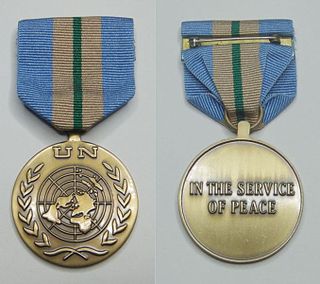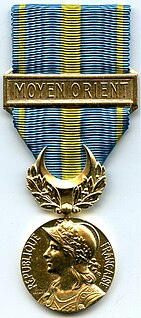
The Suez Crisis, or the Second Arab–Israeli war, also called the tripartite aggression in the Arab world and Sinai War in Israel, was an invasion of Egypt in late 1956 by Israel, followed by the United Kingdom and France. The aims were to regain Western control of the Suez Canal and to remove Egyptian president Gamal Abdel Nasser, who had just nationalised the canal. After the fighting had started, political pressure from the United States, the Soviet Union and the United Nations led to a withdrawal by the three invaders. The episode humiliated the United Kingdom and France and strengthened Nasser.

The United Nations Truce Supervision Organization (UNTSO) is an organization founded on 29 May 1948 for peacekeeping in the Middle East. Its primary task was providing the military command structure to the peacekeeping forces in the Middle East to enable the peacekeepers to observe and maintain the ceasefire, and as may be necessary in assisting the parties to the Armistice Agreements in the supervision of the application and observance of the terms of those Agreements. The command structure of the UNTSO was maintained to cover the later peacekeeping organisations of the United Nations Disengagement Observer Force (UNDOF) and the United Nations Interim Force in Lebanon (UNIFIL).

The American Defense Service Medal was a military award of the United States Armed Forces, established by Executive Order 8808, by President Franklin D. Roosevelt, on June 28, 1941. The medal was intended to recognize those military service members who had served on active duty between September 8, 1939, and December 7, 1941.

A United Nations Medal is an international decoration awarded by the United Nations (UN) to the various world countries members for participation in joint international military and police operations such as peacekeeping, humanitarian efforts, and disaster relief. The medal is ranked in militaries and police forces as a service medal. The United Nations awarded its first medal during the Korean War (1950-53). Since 1955, many additional United Nations medals have been created and awarded for participation in various United Nations missions and actions around the world.
Canada has been a member of the United Nations since it was established, and has served six separate terms on the UN Security Council. Canada has also participated in United Nations peacekeeping missions.

The first United Nations Emergency Force (UNEF) was established by United Nations General Assembly to secure an end to the Suez Crisis with resolution 1001 (ES-I) on 7 November 1956. The force was developed in large measure as a result of efforts by UN Secretary-General Dag Hammarskjöld and a proposal and effort from Canadian Minister of External Affairs Lester B. Pearson, who would later win the Nobel Peace Prize for it. The General Assembly had approved a plan submitted by the Secretary-General which envisaged the deployment of UNEF on both sides of the armistice line. The Second United Nations Emergency Force deployed from October 1973 to July 1979.
Awards and decorations of the United States Department of the Air Force are military decorations which are issued by the Department of the Air Force to airmen of the United States Air Force and guardians of the United States Space Force and members of other military branches serving under Air Force and Space Force commands.

The Australian Cadet Forces Service Medal is awarded to recognise long and efficient service by officers and instructors in the Australian Defence Force Cadets. It is awarded for 15 years service. Additional clasps are issued for every 5 years additional service.

The Anniversary of National Service 1951–1972 Medal is a commemorative medal awarded to Australians for their service in post-war national service schemes.

Canadian-Egyptian relations are foreign relations between Canada and Egypt. Both countries established embassies in their respective capitals in 1954. Canada has an embassy in Cairo. Egypt has an embassy in Ottawa and a Consulate-General in Montreal. Though both had been part of the British Empire, only Canada is part of the Commonwealth, Egypt is not.
Colombian military decorations date back as far as the founding of the country. An early decoration was the Cruz de Boyacá that was awarded to the generals who led their forces to victory in the Battle of Boyacá in 1819. This early decoration lives on today as an incarnation of the highest order presented by the Colombian state. There is one decoration higher, but it is only awarded for military conflicts in defence of Colombia. Other than military decorations, Colombia presents decorations on behalf of the National Government, decorations for the National Police, and decorations from the Congress of Colombia.
The first emergency special session of the United Nations General Assembly was convened on 1 November and ended on 10 November 1956 resolving the Suez Crisis by creating the United Nations Emergency Force to provide an international presence between the belligerents in the canal zone. The emergency special session was convened due to the failure of the Security Council to resolve the instability at the Suez Canal, invoking "Uniting for Peace" resolution which transferred the issue from the Security Council to the General Assembly. On the fourth day of the session the Canadian representative, Lester B. Pearson, introduced the concept of a UN police force. The creation of the United Nations Emergency Force was approved by the General Assembly with 57 supports and zero opposes. The vote had 19 countries abstaining, including the United Kingdom, France, Egypt, the Soviet Union and several Eastern European countries.

The Australian General Service Medal for Korea (AGSMK) recognises former defence force personnel who completed 30 days of service in operations in South Korea, including any location 161 km (100 mi) seaward from the coast of South Korea, during the post-Armistice period, 28 July 1953 to 19 April 1956. The medal was established by letters patent by Queen Elizabeth II on 24 November 2009 and further determination approved by the Governor General on 12 March 2010. The AGSMK was announced on 12 February 2010 by the Parliamentary Secretary for Defence Support, the Hon Dr Mike Kelly AM MP, following the recommendations of the 2005 Post-Armistice Korean Service Review.
The origins of the Six-Day War, which was fought between June 5 and June 10, 1967, by Israel and the neighboring states of Egypt, Jordan, and Syria, include both longstanding and immediate issues. At the time of the Six-Day War, the earlier foundation of Israel, the resulting Palestinian refugee issue, and Israel's participation in the invasion of Egypt during the Suez crisis of 1956 continued to be significant grievances for the Arab world. Arab nationalists, led by Egyptian President Gamal Abdel Nasser, continued to be hostile to Israel's existence and made grave threats against its Jewish population. By the mid-1960s, relations between Israel and its Arab neighbors had deteriorated to the extent that a number of border clashes had taken place.

The United Nations Special Service Medal (UNSSM) is presented to personnel with 90 days of service with a United Nations mission not covered by a specific United Nations Medal. United Nations Headquarters service is not eligible.

The Commemorative medal for United Nations operations in Korea was a French commemorative war medal established on 8 January 1952 by decree 52-34 for award to members of the French armed forces who fought in the Korean war.

The Middle East operations commemorative medal was a French commemorative medal established on 22 May 1957 to recognize the participation of French nationals in the military operations conducted during the Suez Crisis of 1956.

The second United Nations Emergency Forces was established by United Nations General Assembly, in accordance with United Nations Security Council Resolution 340 (1973), to supervise the ceasefire between Egyptian and Israeli forces at the end of Yom Kippur War, and following of the agreement of 18 January 1974 and 4 September 1975, to supervise the redeployment of Egyptian and Israeli forces and to man and control the buffer zones established under those agreements.
The United Nations Peacekeepers Medal is awarded to those members of the Irish Defence Forces or Chaplaincy Service who have served overseas on a United Nation Mission or United Nations Mandated Mission.













